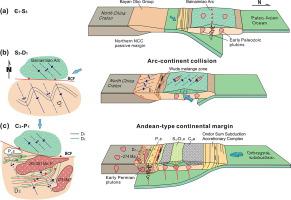当前位置:
X-MOL 学术
›
J. Asian Earth Sci.
›
论文详情
Our official English website, www.x-mol.net, welcomes your
feedback! (Note: you will need to create a separate account there.)
From oblique arc-continent collision to orthogonal plate subduction in the southeastern Central Asia Orogenic Belt during Paleozoic: Evidence from superimposed folds at the northern margin of the North China Craton
Journal of Asian Earth Sciences ( IF 2.7 ) Pub Date : 2020-09-01 , DOI: 10.1016/j.jseaes.2020.104499 Liyu Hou , Changhou Zhang , Yi Lin , Chengming Li , Yingzhu Huang , Teng Dong , Hongmei Wu
Journal of Asian Earth Sciences ( IF 2.7 ) Pub Date : 2020-09-01 , DOI: 10.1016/j.jseaes.2020.104499 Liyu Hou , Changhou Zhang , Yi Lin , Chengming Li , Yingzhu Huang , Teng Dong , Hongmei Wu

|
Abstract Accretionary kinematic history of the Central Asia Orogenic Belt (CAOB) remains unclear in previous geological studies. Based on detailed structural analysis of newly identified folds on the northern margin of the North China Craton (NCC), we propose a tectonic model suggesting that Paleozoic accretion of the orogenic belt includes two phases of deformation. The first phase of deformation is oblique collision of the Bainaimiao Arc and the NCC, which was followed by orthogonal subduction of the Paleo-Asian Ocean in the second phase of deformation. The change of plate kinematics is supported by two generations of folding, namely D1 (DB) and D2 (DA). Both D1 (DB) and D2 (DA) folds developed in the Bayan Obo Group (BOG), a Meso- and Neoproterozoic rift sequence deposited on the passive continental margin of the NCC. D1 (DB) folds were superimposed by the east-west trending D2 (DA) folds. The D1 (DB) folds developed as a result of oblique collision of the Bainaimiao arc and the NCC. The D2 (DA) folds developed in response to the southward orthogonal subduction of the Paleo-Asian Ocean Plate. They formed between latest Silurian and Early Permian, coeval with the two accretion events at the northern edge of the NCC. Our study suggests that multiphase deformation of sedimentary layers on the subducting plates provide important constraints for kinematic evolution of plate tectonics.
中文翻译:

古生代中亚造山带东南部从斜弧陆碰撞到正交板块俯冲——来自华北克拉通北缘叠合褶皱的证据
摘要 中亚造山带(CAOB)的增生运动史在以往的地质研究中仍不清楚。基于对华北克拉通(NCC)北缘新发现的褶皱的详细结构分析,我们提出了一个构造模型,表明造山带的古生代增生包括两个变形阶段。变形的第一阶段是白内庙弧与华北克拉通的斜向碰撞,变形的第二阶段是古亚洲洋的正交俯冲。板运动学的变化由两代折叠支持,即D1(DB)和D2(DA)。D1 (DB) 和 D2 (DA) 褶皱均在白云鄂博群 (BOG) 中发育,白云鄂博群 (BOG) 是沉积在华北克拉通被动大陆边缘的中、新元古代裂谷序列。D1 (DB) 褶皱由东西走向的 D2 (DA) 褶皱叠加。D1 (DB) 褶皱是白奈庙弧和 NCC 斜向碰撞的结果。D2 (DA) 褶皱是响应古亚洲大洋板块向南正交俯冲而形成的。它们形成于晚志留纪和早二叠纪之间,与 NCC 北部边缘的两次吸积事件同时发生。我们的研究表明,俯冲板块上沉积层的多相变形为板块构造运动演化提供了重要约束。它们形成于晚志留纪和早二叠纪之间,与 NCC 北部边缘的两次吸积事件同时发生。我们的研究表明,俯冲板块上沉积层的多相变形为板块构造运动演化提供了重要约束。它们形成于晚志留纪和早二叠纪之间,与 NCC 北部边缘的两次吸积事件同时发生。我们的研究表明,俯冲板块上沉积层的多相变形为板块构造运动演化提供了重要约束。
更新日期:2020-09-01
中文翻译:

古生代中亚造山带东南部从斜弧陆碰撞到正交板块俯冲——来自华北克拉通北缘叠合褶皱的证据
摘要 中亚造山带(CAOB)的增生运动史在以往的地质研究中仍不清楚。基于对华北克拉通(NCC)北缘新发现的褶皱的详细结构分析,我们提出了一个构造模型,表明造山带的古生代增生包括两个变形阶段。变形的第一阶段是白内庙弧与华北克拉通的斜向碰撞,变形的第二阶段是古亚洲洋的正交俯冲。板运动学的变化由两代折叠支持,即D1(DB)和D2(DA)。D1 (DB) 和 D2 (DA) 褶皱均在白云鄂博群 (BOG) 中发育,白云鄂博群 (BOG) 是沉积在华北克拉通被动大陆边缘的中、新元古代裂谷序列。D1 (DB) 褶皱由东西走向的 D2 (DA) 褶皱叠加。D1 (DB) 褶皱是白奈庙弧和 NCC 斜向碰撞的结果。D2 (DA) 褶皱是响应古亚洲大洋板块向南正交俯冲而形成的。它们形成于晚志留纪和早二叠纪之间,与 NCC 北部边缘的两次吸积事件同时发生。我们的研究表明,俯冲板块上沉积层的多相变形为板块构造运动演化提供了重要约束。它们形成于晚志留纪和早二叠纪之间,与 NCC 北部边缘的两次吸积事件同时发生。我们的研究表明,俯冲板块上沉积层的多相变形为板块构造运动演化提供了重要约束。它们形成于晚志留纪和早二叠纪之间,与 NCC 北部边缘的两次吸积事件同时发生。我们的研究表明,俯冲板块上沉积层的多相变形为板块构造运动演化提供了重要约束。









































 京公网安备 11010802027423号
京公网安备 11010802027423号